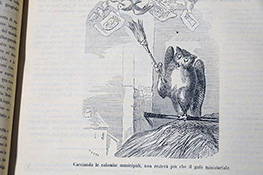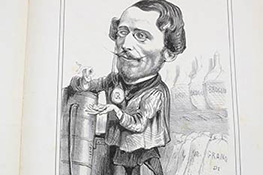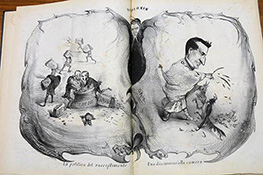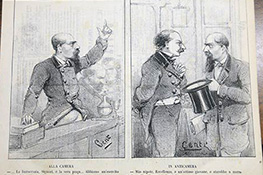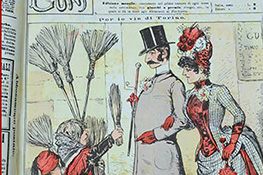Versione italiana English version Version française Versión en español
Humoristical-satirical journals in Turin during '800
Social-political satire in Italy during the XIX century wasn't a prerogative o poets' only, from the Batracomiomachia by the great Leopardi to the sonnets by the not less great Porta and Belli, to the biting lines by Giuseppe Giusti. Because of the Constitutions promulgated in 1848, a lot of periodicals raised, rich of satirical written and comic strips. The comunicative power of strips must be considered, in an era when illiteracy in Italy involved two thirds of the population.
The progenitor is il Caffè Pedrocchi, born in Venice 1846, but wasn't publishing drawings yet; in 1848 in Naples there were L'arlecchino and Il Lampione (also directed by Collodi) in Florence. Also in 1848 was founded in Milan Lo spirito folletto, with which worked many great caricaturists, such as Camillo Marietti from Turin, considered the greatest personal caricaturist of the century. Marietti also worked with Fischietto, a three week liberal cavourian periodical that was first released in Turin the second of November 1848, proposing "actuality oddnesses" with "original drawings".
It should be reminded that in the Sardinia Reign the edict about print promulgated the 26th of March 1848 with a few days of distance from the Statuto Albertino to which is linked, and preceded by the law about print of the 30th October 1847, represents a mile stone of the history of Italian journalism. Many of its rules remained valid even after the foundation of the Reign of Italy. It deeply changed the concept of print freedom: from a preventive censorship to an administrative control against abuses criminalized by the penal code.
Il Fischietto had the goal of "whistling on injustices". Cavourian, so antimazzinian and anticlerical, was sequestered many times and didn't spread so much out of Piedmont. It reaches 3000 copies of printing anyway, thanks to the collaboration of the great drawers Puff and Giulio (pseudonyms of Casimiro Teja and Jules Plattier), Ippolito Virginio, Icilio Pedrone, Camillo Marietti and Francesco redenti (Cesare Vienna), whose boards were hanged on the walls of Milan during the Five Days. Directed by Vittorio Bersezio, Redenti, Marietti, Arturo Calleri (Caronte) and Giorgio Ansaldi (Dalsani), in 1870 Il Fischietto (that continued to be printed until 1916) absorbed the magazine Il Diavolo. This one, founded in Turin in 1862, was characterized for the graphic beauty and the caricatures in big size that decorated the third page. Giulio Gorra, Luigi Borgomainerio, Giorgio Ansaldi used to sigh its illustrations. Of democratic views, was sequestered many times. Turned into Messaggere Torinese in 1872, stopped the publications a year later.
Also in Turin was born in 1856 the Pasquino, named after the "speaking statue" in Rome like the Milan Man of Stone. The great illustrator Casimiro Teja, who directed it until the last day of his life, was followed by Giorgio Ansaldi, Luigi Sapelli, Giovanni Manca, Enrico Gianeri. In 1930 it was deleted by fascism.
Something must be also said about the twice a week journal Un soldo and the humor three times a week one Gianduia (released from 1862 to 1864. From 1866 will be published Gazeta d'Gianduja in Piedmont dialect, twice a week of dialogues and poems about historical actuality). The weekly La Luna was more about costume satire than the political one, humor journal of theaters.
We cannot forget that in Turin was born the Il Mondo illustrato, a universal journal with many engravings through the text, printed by the editor Giuseppe Pomba. It was released from the 2nd of January 1847 to the 30th of December 1848, the first illustrated magazine in Italy. It also had the first images of Gianduja. Some boards about Gianduja (La via crucis di Gianduja), printed for the magazine Buonumore in 1864, after the bloody scuffles to move the capital from Turin to Florence, cost the job to the illustrator Alessandro Allis. In La via crucis di Gianduja made of fourteen allegorical boards, Gianduja was represented while carrying a cross of redemption for the Unified Italy; in the 12th station he appeared crucified in Piazza San Carlo, stabbed by bayonets. The work was sequestered at once not for blasphemy but because between the responsible of the Passion there were many political men of that period, such as Minghetti, Lamarmora, Ricasoli...

